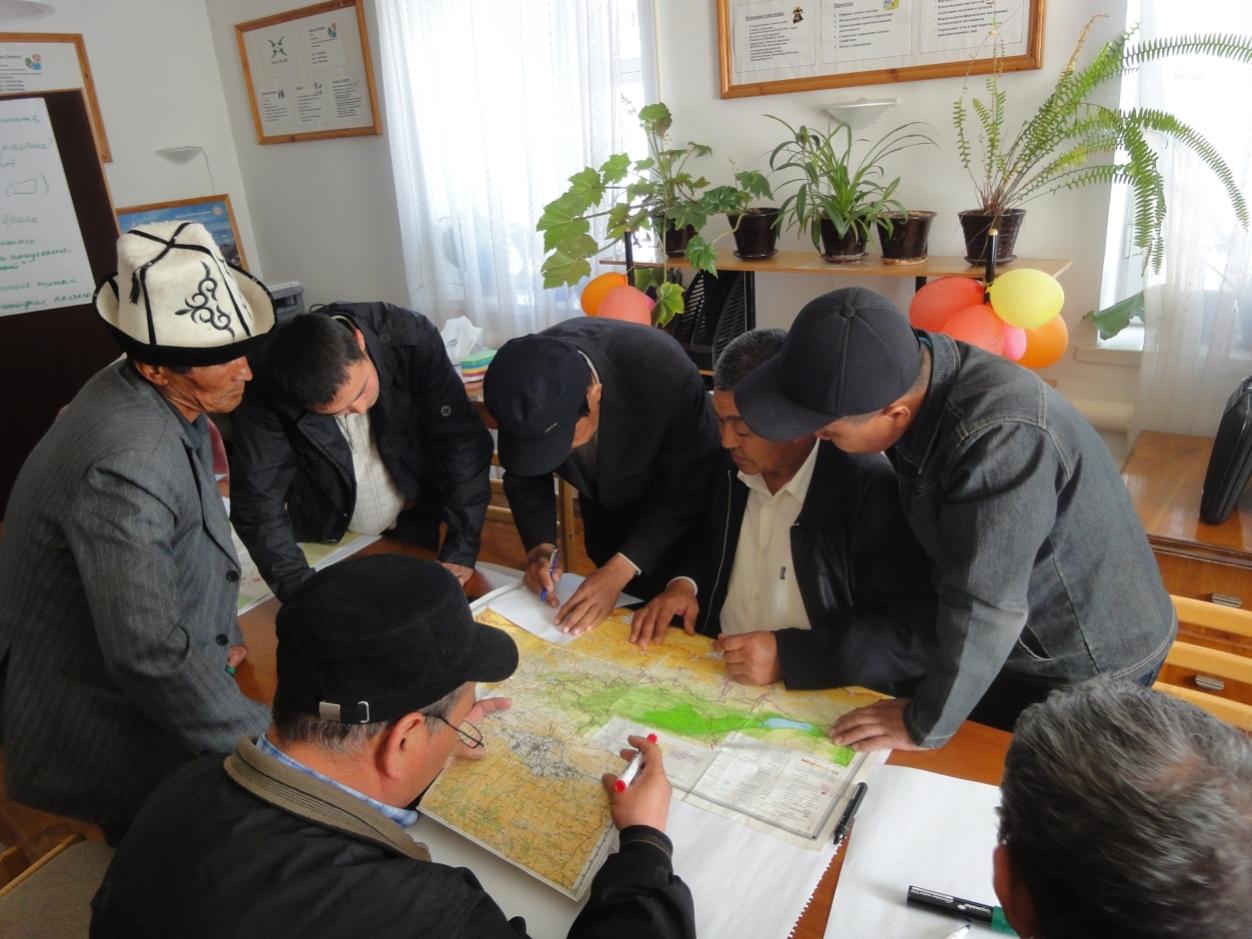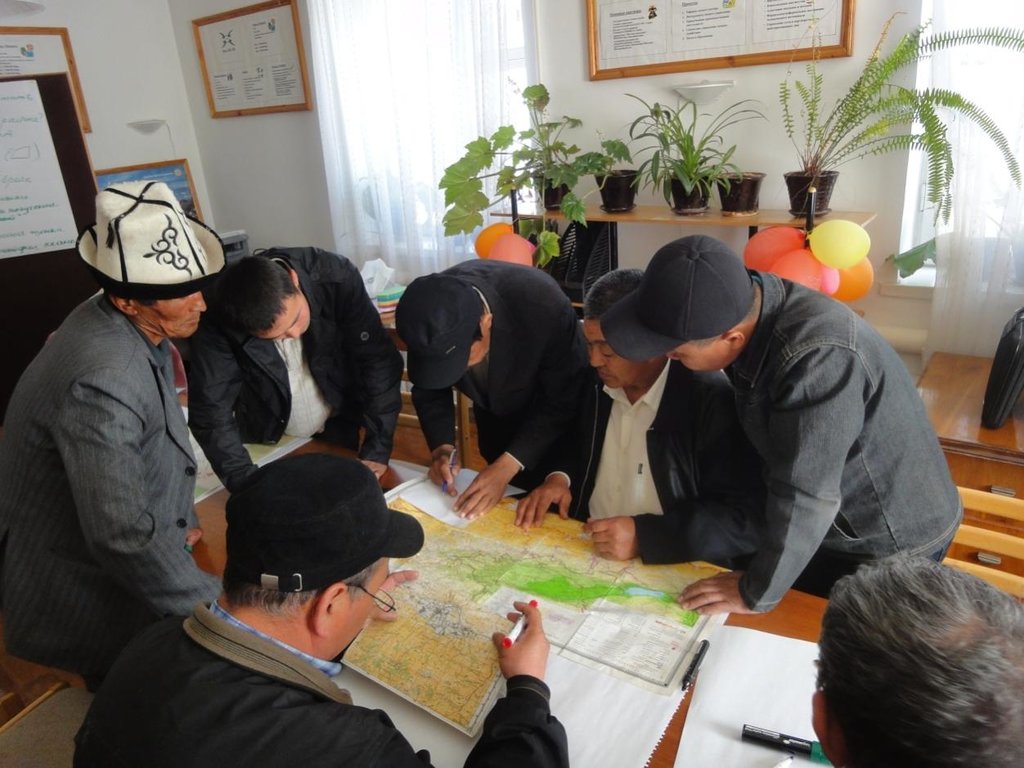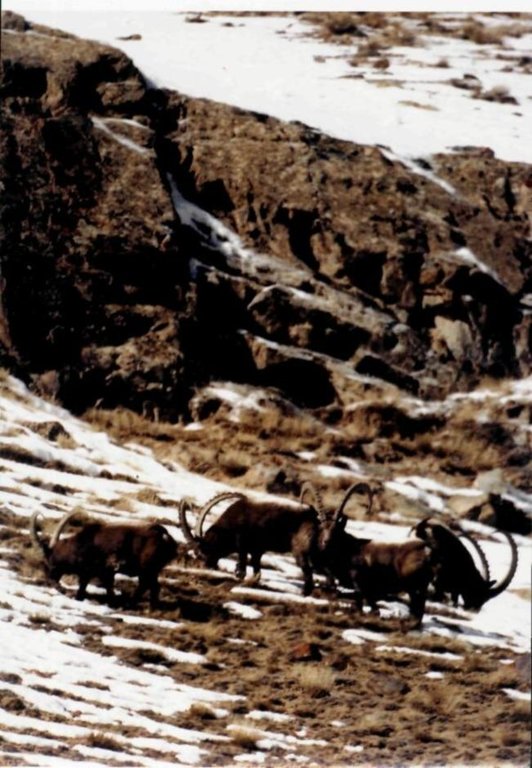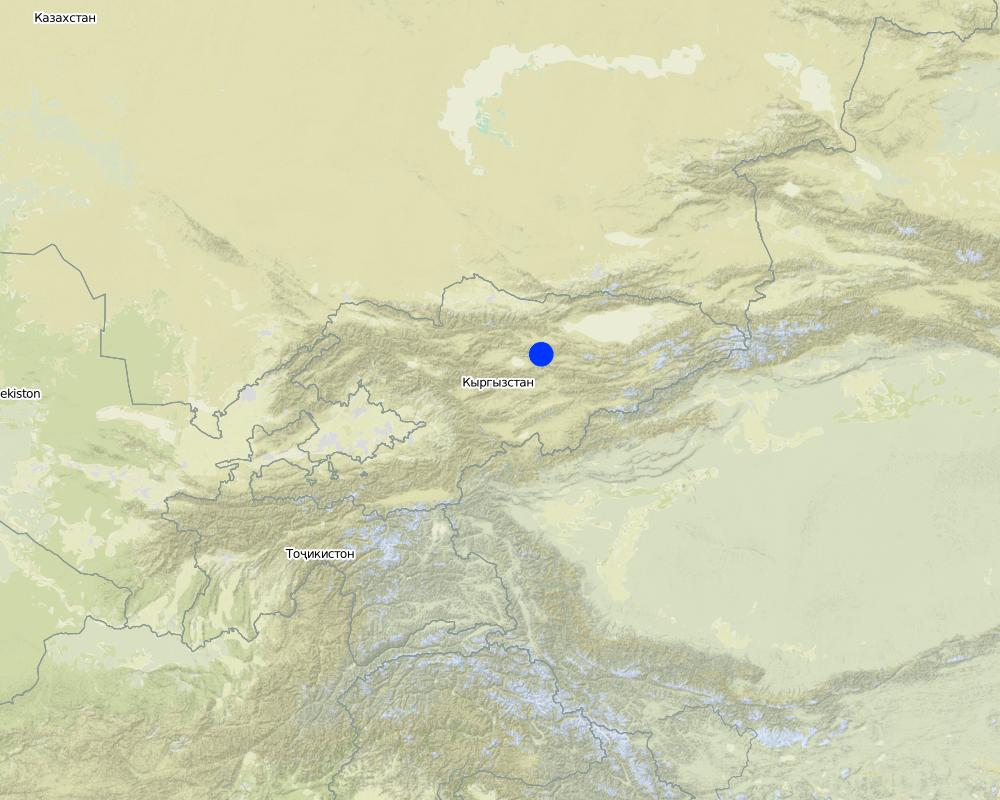Joint Wildlife Management in the mountain ecosystem of the Naryn region in Kyrgyzstan [Kirguistán]
- Creación:
- Actualización:
- Compilador: Nazgul Esengulova
- Editor: –
- Revisor: Alexandra Gavilano
Нарын областында тоолуу экосистемаларынын табигый анчылык ресурстарын жергиликтуу жамааттардын негизинде колдонуу
approaches_2582 - Kirguistán
Visualizar secciones
Expandir todo Colapsar todos1. Información general
1.3 Condiciones referidas al uso de datos documentados mediante WOCAT
¿Cuándo se compilaron los datos (en el campo)?
11/05/2012
El compilador y la/s persona(s) de referencia claves aceptan las condiciones acerca del uso de los datos documentados mediante WOCAT :
Sí
2. Descripción del Enfoque MST
2.1 Breve descripción del Enfoque
Joint Wildlife Management based on economic empowerment and assigning hunting (wildlife) grounds to the Association of local hunters and providing her with user rights for game resources leads to a sustainable use of natural resources and biodiversity and wildlife conservation (in the frame of CACILM).
2.2 Descripción detallada del Enfoque MST
Descripción detallada del Enfoque MST:
Aims / objectives: Wildlife in Kyrgyzstan, especially mountain ungulates, is threatened because these resources can be easily accessed due to an inadequate state supervision and regulation as well as due to lack of knowledge among the local population and mechanism for integrated land use (considering different coordinated types of resource use) and resource conservation. Decrease in the natural habitat (caused by the expansion of pasture and arable land) and illegal hunting lead to a decrease in wildlife populations. In Kyrgyzstan, the fauna is exclusively owned by the state. User rights for wildlife are separated from land use ones. The approach aims at the conservation and sustainable use of wildlife based on providing representatives of the local community, organized in an Association of local hunters (ALH), with legal user rights for wildlife resources.
Methods: (1) supporting local hunters in organizing an Association of local hunters (ALH) with the help of facilitators; (2) transferring wildlife management functions from the Wildlife Department to the ALH based on assigning hunting grounds to them and providing them with user rights according to jointly developed management plans; (3) building trust in partnership relations between the ALH and the Wildlife Department of State Agency for Environmental Protection and Forestry (SAEPF) based on joint registration and monitoring and determination of the resource status (see Annex 3); (4) capacity building of the ALH with the help of independent experts and advising activities provided by the Wildlife Department; (5) developing an atmosphere of trust by establishing links between the Wildlife Department, local hunters (ALH), the local community (Aiylokmotu) and rural organizations (Pasture User Association, PUA) based on joint planning and information sharing.
Stages of implementation: (1) setting up groups of well-trained (sensitive) facilitators and training them on the principles of facilitation, conflict management and sustainable management of natural resources; (2) identifying reliable active hunters with the help of facilitators and managers by interviewing neutral people; (3) organizing a meeting at the field level to analyze the situation and identify interests in establishing of the ALH; (4) raising awareness of local hunters on wildlife resources, existing problems and possible solutions offered by sustainable management; (5) establishing an ALH in the pilot area as a legal entity; (6) assigning areas to the ALH and advising activities on methods for wildlife management provided by the Wildlife Department and the specialized NGO 'Ak-Terek'; (7) organizing expeditions with specialists from the Wildlife Department to register and monitor the resource status; (8) developing a management plan with the support of experts from the Wildlife Department and independent experts, plan approval and implementation.
2.3 Fotos del Enfoque
2.5 País/ región/ lugares donde el Enfoque fue aplicado
País:
Kirguistán
Región/ Estado/ Provincia:
Kyrgyzstan, Naryn oblast
Especifique más el lugar :
Kochkor district, Toloksky Aiylokmotu (villages Tolok and Kok-Jar)
Map
×2.6 Fechas de inicio y conclusión del Enfoque
Indique año del inicio:
2010
Año de conclusión (si el Enfoque ya no se aplica):
2014
2.7 Tipo de Enfoque
- proyecto/ basado en un programa
2.8 Propósitos/ objetivos principales del Enfoque
The Approach focused mainly on other activities than SLM (Transferring responsibilities of wildlife management to the local population, assigning hunting grounds to the Association of local Hunters and providing her with legal user rights for game resources, sustainable management of wildlife and joint planning)
The approach aims at conservation and sustainable use of wildlife based on economic empowerment and transfer of legal use rights for wildlife resources to representatives of the local community, organized in the Association of local hunters according to jointly developed management plans.
The SLM Approach addressed the following problems: Decrease in wildlife populations due to an unregulated unsustainable use of resources by the local population and due to lack of participatory mechanisms for the population to manage these resources, inadequate state regulation and supervision, aggravated by a conflict of interest among users over other natural resources with different intentions (pasture, forest, mineral resources, tourism).
2.9 Condiciones que facilitan o impiden la implementación de la/s Tecnología/s aplicadas bajo el Enfoque
normas y valores sociales/ culturales/ religiosos
- impiden
Hunting is basically illegal. Local hunters do not trust the new approach of wildlife management and have no capacity for self-organization and no experience of joint decision making.
Treatment through the SLM Approach: Providing necessary information to the local population by holding meetings and seminars with representatives of the Wildlife Department. Trainings on capacity building for self-organization.
disponibilidad/ acceso a recursos y servicios financieros
- impiden
There is a need for initial investment to get the ALH started and deferred revenues are expected. The ALH is not expected to extract big financial revenues from wildlife management and wildlife use.
Treatment through the SLM Approach: Explanation of financial expectations (exclusive right of first access to game resources and authority of access right distribution, patriotism)
entorno institucional
- impiden
There is a lack of joint organizations at the field level which manage wildlife resources sustainably.
Treatment through the SLM Approach: Establishing an Association of local hunters to manage wildlife resources sustainably
marco de trabajo legal (tenencia de tierra, derechos de uso de tierra y agua)
- impiden
There is a lack of policy promoting Joint Wildlife Management
Treatment through the SLM Approach: Order of the Wildlife Department, Concept of Reform for wildlife sector prohibiting state agencies to manage wildlife economically, promoting the assignment of wildlife areas to the ALH
The existing land ownership, land use rights / water rights greatly hindered the approach implementation Existing legislation does not comply with the principles of sustainable use and wildlife management and does not promote Joint Wildlife Management. There is a lack of regulation and integration of land users.
conocimiento de MST, acceso a apoyo técnico
- impiden
The local population has no necessary capacities (environmental awareness, knowledge of sustainable wildlife management).
Treatment through the SLM Approach: Trainings
3. Participación y roles de las partes interesadas involucradas
3.2 Involucramiento de los usuarios locales de tierras/ comunidades locales en las distintas fases del Enfoque
| Involucramiento de los usuarios locales de tierras/ comunidades locales | Especifique quién se involucró y describa las actividades | |
|---|---|---|
| iniciación/ motivación | interactivo | Consulting with the Wildlife Department |
| planificación | interactivo | Participation at discussing the approach design and determining the form and specifics of self-organization |
| implementación | interactivo | Local hunters implement the approach through their representatives in the ALH |
| monitoreo y evaluación | interactivo | Monitoring and evaluation are conducted on base of questionnaires and interviews with key actors supported by the Wildlife Department and GIZ Project and on base of annual progress assessment in reports prepared for the Wildlife Department (increase in wildlife population, reducing conflicts among resource users). |
| Research | ninguno |
3.3 Flujograma (si estuviera disponible)
Descripción:
The approach has been implemented by the GIZ project 'Sustainable management of the mountain ungulate species' under the Regional Program on Sustainable Use of Natural Resources in Central Asia which initiated and implemented establishment of the ALH in conjunction with the Wildlife Department and the NGO 'Ak-Terek'. The Wildlife Department has developed new methods for monitoring and determining wildlife quotas. The NGO 'Ak-Terek' promotes and facilitates self-organization of hunters in the ALH, mitigate possible conflicts arising in the integrated land use. Local hunters are organized into the ALH, defining her structure and principles of organization (legal status, functions, membership), as well as monitoring and developing management plan, etc. The Wildlife Department confirms the legal assignment of wildlife areas to the ALH and provides advice to them on game management.
Autor:
Nazgul Esengulova (720001, Logvinenko St., 26а, Bishkek, Kyrgyzstan )
3.4 La toma de decisiones en la selección de Tecnología(s) MST
Las decisiones para la selección de la/s Tecnología(s) fueron tomadas:
- Experts from the Wildlife Department
Explique:
In a seminar involving the local population and project experts and experts from the NGO 'Ak-Terek' as facilitators in order to explain the principles of wildlife management.
Decisions on the method of implementing the SLM Technology were made by mainly by land users supported by SLM specialists. Decisions were made by the village population supported by WLD experts.
In the meeting of key hunters, shepherds and other interested residents of the village with the project staff and the Foundation 'Ak-Terek', there was determined a form of local self-organization of wildlife users.
4. Apoyo técnico, fortalecimiento institucional y gestión del conocimiento
4.1 Construcción de capacidades / capacitación
¿Se proporcionó la capacitación a usuarios de tierras/ otras partes interesadas?
Sí
Especifique quién fue capacitado:
- usuarios de tierras
- Wildlife Department
Si fuese relevante, también especifique género, edad, estatus, etnicidad, etc.
Mainly males at age 40-50
Forma de capacitación:
- en el contexto de trabajo
- de agricultor a agricultor
- reuniones públicas
Forma de capacitación:
- 2 day seminars on the spot
Temas avanzados:
1. Raising awareness of actual problems and possible solutions; joint mapping of resources and discussion of scenarios for development of hunting grounds;
2. Principles of sustainable wildlife use;
3. Methods for monitoring and registering the number of wild animals;
4. Planning economic activities of game management for an assigned area;
5. Professional ethics of game users;
6. Programs for employees of environmental, law enforcement and customs authorities.
4.2 Servicio de asesoría
¿Los usuarios de tierras tienen acceso a un servicio de asesoría?
Sí
Describa/ comentarios:
Name of method used for advisory service: situation analysis; Key elements: on-site visit, group consultation during workshop, preparation of resource map
Advisory service is quite adequate to ensure the continuation of land conservation activities; Department with its local staff and the NGO 'Ak-Terek' are capable to continue providing advisory services after the project finishes.
4.3 Fortalecimiento institucional (desarrollo institucional)
¿Se establecieron o fortalecieron instituciones mediante el Enfoque?
- no
4.4 Monitoreo y evaluación
¿El monitoreo y la evaluación forman parte del Enfoque?
Sí
Comentarios:
bio-physical aspects were regular monitored by project staff, land users through observations; indicators: expeditions, field researches, surveys
bio-physical aspects were regular monitored by project staff, land users through measurements; indicators: number of wild animals
economic / production aspects were regular monitored by project staff through measurements; indicators: benefit from selling hunting tours and ecotourism
no. of land users involved aspects were regular monitored by project staff through measurements; indicators: Number of hunters and associations
management of Approach aspects were regular monitored by project staff, government through observations; indicators: annual planning, monitoring of achievement and difficulties, adaptation of the approach if necessary
There were no changes in the Approach as a result of monitoring and evaluation: None
There were no changes in the Technology as a result of monitoring and evaluation: None
5. Financiamiento y apoyo material externo
5.1 Presupuesto anual para el componente MST del Enfoque
Si no se conoce el presupuesto anual preciso, indique el rango:
- 10,000-100,000
Comentarios (ej. fuentes principales de financiamiento/ donantes principales):
Approach costs were met by the following donors: international (GIZ, via “Sustainable use of the mountain ungulate species in Kyrgyzstan” ): 95.0%; government (Wildlife Department of SAEPF): 5.0%; national non-government (PF “Ak-Terek” ); local community / land user(s) (local resource users )
5.3 Subsidios para insumos específicos (incluyendo mano de obra)
Comentarios:
Voluntary participation in monitoring and registering as well as analyzing wildlife areas for the further assignment of hunting grounds to hunters
5.4 Crédito
¿Se proporcionó crédito bajo el Enfoque para actividades MST?
No
6. Análisis de impacto y comentarios de conclusión
6.1 Impactos del Enfoque
¿El Enfoque ayudó a los usuarios de tierras a implementar y mantener Tecnologías MST?
- No
- Sí, un poco
- Sí, moderadamente
- Sí, mucho
With establishing the Association of local hunters and involving the latter into wildlife management, stabilization and even an increasing tendency of wildlife populations according to ecosystem's carrying capacity have been made possible. Joint planning and activities in the assigned areas decreased the number of conflicts over resources. Diversification of land use and a better integration of land users are present.
¿El Enfoque empoderó a grupos en desventaja social y económica?
- No
- Sí, un poco
- Sí, moderadamente
- Sí, mucho
¿El Enfoque mejoró cuestiones de tenencia de tierra/ derechos de usuarios que obstaculizaron la implementación de la Tecnologías MST?
- No
- Sí, un poco
- Sí, moderadamente
- Sí, mucho
Integrating approaches of wildlife management (a relevant order of the Hunting Department) before a new law 'On Hunting' is adopted. Economic empowerment of the LAH and political will for the issue. Increase in sensibility of the main resource users concerning the conservation of biodiversity.
Did other land users / projects adopt the Approach?
- No
- Sí, un poco
- Sí, moderadamente
- Sí, mucho
The project is extended over other areas in Kyrgyzstan (Kemin, Ak-Suu and Talas regions) and in Khatlon and Gorno-Badakhshan oblasts of Tajikistan (Shurabad, Darvaz, Rushan, Ishkakshim, Murghab regions).
Did the Approach lead to improved livelihoods / human well-being?
- No
- Sí, un poco
- Sí, moderadamente
- Sí, mucho
Legally ongoing recreational hunting. Revenue increase resulting from the wildlife protection due to legalization of hunting and sustainable resource management.
Did the Approach help to alleviate poverty?
- No
- Sí, un poco
- Sí, moderadamente
- Sí, mucho
Since the target group does not refer to very poor people
6.2 Motivación principal del usuario de la tierra para implementar MST
- incremento de la renta(bilidad), proporción mejorada de costo-beneficio
Additional income from hunting tours
- reglas y reglamentos (multas)/ aplicación
Legalization of hunting
- prestigio, presión social/ cohesión social
Attitude of local people to illegal hunting
- environmental consciousness, moral, health
Moral improvement of society
- well-being and livelihoods improvement
Additional income from hunting tours
- Improvement of ecosystem
Wildlife protection improves the ecosystem where local people live
6.3 Sostenibilidad de las actividades del Enfoque
¿Pueden los usuarios de tierras sostener lo que se implementó mediante el Enfoque (sin apoyo externo)?
- sí
Si respondió que sí, describa cómo:
5 years later, after the number of wild animals in the assigned area is increased. During this period, members of the Association would realize the obvious long-term benefits resulting from the new approach (increasing wildlife population would lead to an increase in hunting licenses issued) and would become experienced in sustainable game management.
6.4 Fortalezas/ ventajas del Enfoque
| Fuerzas/ ventajas/ oportunidades desde la perspectiva del usuario de la tierra |
|---|
| Opportunity to lobby for own interests through Hunters’ Association in the local community (Aiylokmotu). |
| Opportunity to extract revenue from hunting tours. |
| Opportunity to legalize hunting. |
| Opportunity to manage resources in the assigned area and to plan how to use them. (How to sustain/ enhance this strength: Trainings and expert advice from the Wildlife Department and the Academy of Sciences of KR.) |
| Fuerzas/ ventajas/ oportunidades desde la perspectiva del compilador o de otra persona de referencia clave |
|---|
| Users of various natural resources (pasture, beekeepers, hunters) jointly plan their activities and use resources. (How to sustain/ enhance this strength: Increasing awareness of the local population on degradation of natural resources and the need for their careful use.) |
| Resource use and management are transferred in the hands of resource users. (How to sustain/ enhance this strength: Adoption of necessary legislation to establish wildlife user associations.) |
| Positive impact on the local ecosystem: stabilization of the wildlife population resulting from of protection of the assigned area and limited shooting. (How to sustain/ enhance this strength: Trainings for hunters on a new method of registration and monitoring of wild animals in order to determine the status of wildlife populations.) |
| Active and regular participation and support of the Wildlife Department in planning and implementing approach and creating an atmosphere of trust. |
6.5 Debilidades/ desventajas del Enfoque y formas de sobreponerse a ellos
| Debilidades/ desventajas/ riesgos desde la perspectiva del usuario de la tierra | ¿Cómo sobreponerse a ellas? |
|---|---|
| Deferred minor revenue over the first years of implementation related to an increase in wildlife populations. | Development of ecotourism as a primary source of income. In the future, ecotourism can be practiced along with hunting tourism, providing additional income. |
| Debilidades/ desventajas/ riesgos desde la perspectiva del compilador o de otra persona de referencia clave | ¿Cómo sobreponerse a ellas? |
|---|---|
| Resource users have poor capacities for self-organization and are incapable of coherent collective actions. | Consultancy, meetings, involvement of conflict managers and facilitators. |
7. Referencias y vínculos
7.2 Referencias a publicaciones disponibles
Título, autor, año, ISBN:
Final Report for GIZ 'Analysis and Preliminary Results of the Joint Wildlife Management Component of the Project
¿Dónde se halla disponible? ¿Costo?
Pesch Markus
Vínculos y módulos
Expandir todo Colapsar todosVínculos
No hay vínculos
Módulos
No se hallaron módulos






